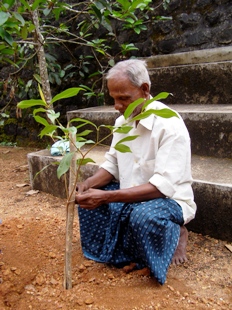| |
|
 |
Indian spiritual leaders go green: five inspiring examples of good practice
June 2, 2009:
 |
 |
 |
7.5 million trees have been planted in Karnataka and Tamil Nadu by the Hindu Isha Foundation - giving the group a place in the Guinness Book of Records |
Here are five examples of Indian spiritual sects, promoting green causes through recognizing that preservation of natural elements is at the country's spiritual core.
1. Hindus in the UK meet to plan a Nine Year Plan to Protect the Environment for generations
2. 40 Day Himalayan March to Promote Walking Lightly on the Earth
3. Cleaning the Ganga River
4. Setting an example with Organic Farming
5. The Global Tree Planter
1. Hindus in the UK Led by the Oxford Centre for Hindu Studies and assisted by ARC, Hindus in the UK will draw up a 9 Year Hindu Plan to protect the Environment. This is a Public Space Project for the OCHS, bringing together four leading temples: Bhaktivedanta Manor, Sri Swaminarayan Mandir in Neasden, Sanatana Manadir in Leicester and Shri Venkateswara Temple in Birmingham, as well as Krishna-Avanti Primary School and Hindus for Sustainable Life. Temples are each to draw up their recommendations for their own Nine Year plan and then bring to the wider Hindu community by mid July.
2. 40 Day Himalayan March to Promote Walking Lightly on the Earth
 |
 |
 |
The engagement of young people is key to the environmental future of India |
Some 1,000 Buddhist monks, nuns and followers set off on a 400-km spiritual trek across five high Himalayan passes in mid May 2009. They were traveling from Kardang in Lahaul Valley in Himachal Pradesh to Leh in Ladakh to promote protection of environment and sustainable lifestyles in the region. The 40-day trek is to say “no” to plastic bags, a major pollutant in the fragile ecological zone.
The trekkers are led by Gyalwang Drukpa, the head of the Drukpa Buddhist sect, head-quartered at Hemis Monastery in Ladakh. They are distributing canvas bags to more than 100,000 villagers along the way as a symbolic gesture to shun plastic bags and switch to carry-bags made of eco-friendly material. The marchers will also raise funds - $30 per km - to spread education and sustainable eco-friendly lifestyle awareness in the Himalayan villages.
"This year, we wanted to promote something that purges pollution. Since plastic litter is one of the major eco-concerns in the region, we decided to teach the villagers healthy alternatives. We are in the wheel of a revolution and the way to carry it forward is to lead a clean life,” Gyalwang Drukpa told the Indo-Asian News Service.
"Thousands of disciples from Europe and Japan who visit my monastery in Hemis requested that we do something in a sustained manner to turn the wheel of revolution so that more people can identify with the spiritual movement and can make their lives better."
The trekkers will also champion the cause of "balanced education for children of the Himalayas" for sustainable livelihoods at the Drukpa sect's eco-friendly "Druk White Lotus School" in Ladakh that has won international acclaim as the best green school building in Asia.
"We want more children to study in our school and learn to lead balanced lives without losing touch with their culture and environment," the spiritual leader said. The Drukpa Buddhists have also been given land along the Indus River upstream from Ladakh to create new woodlands by planting trees.
3. Cleaning the Ganga RiverThe Ganga - the ninth longest river in the world - is contaminated almost throughout its 2,500-km course.
"A clean environment is the cornerstone of a clean, healthy and strong India," says Ramdev, co-founder of the Patanjali Yog Peeth near Hardwar.
He is leading a campaign under the banner of Ganga Raksha Manch to clean the Ganga - from its source in Gangotri to Ganga Sagar where it drains into the Bay of Bengal – and to oppose the current unplanned industrialisation along the river.
The campaign has managed to mobilise nearly 700,000 youths at the district level. "The government has granted the Ganga national heritage status after our efforts for almost a year," said Ramdev.
4. Setting an example with Organic FarmingAfter hosting a national environment summit in his retreat in 2008, spiritual guru Sri Sri Ravi Shankar has been campaigning against global warming and agri-pollution through promoting "organic farming", plantations and traditional farm technologies. His Art of Living Foundation headquarters on the outskirts of Bangalore is a model for sustainable ecological conservation and traditional farming. "The only way to check environment pollution is to spread awareness. Many people in this world live without the knowledge of climate. They are immune even to changes in the cycle of seasons. They have to be educated," Sri Sri said.
5. The Global Tree PlanterIn 2006 the Isha Foundation, based in Coimbatore, Tamil Nadu, entered the Guinness Book of World Records for an eco-conservation campaign, "Project Greenhand", which has planted 7.5 million trees in Karnataka and Tamil Nadu. It is led by Jaggi Vasudev. Most of the foundation's members are young professionals.
This article is based on an article in the Times of India, titled “Indian spiritual leaders go green” by IANS, May 30, 2009
LINKSLatest news about the Seven Year Plans.
|
 |
 |
|
|
|
|
|
 |
June 8, 2009:
Druze dedicate Lebanon's fragile Jisr el Qadi region as a Sacred Gift
The journey to create the most recent Sacred Gift started in 2003 when ARC met some of the key Druze decision-makers within the Shouf Valley. Sheikh Sami attended ARC meetings in Turkey and Sweden to discuss investments and forestry, “and when I returned from Sweden I was convinced it was time for the Druze to create a sacred gift.” |
 |
 |
|
|

